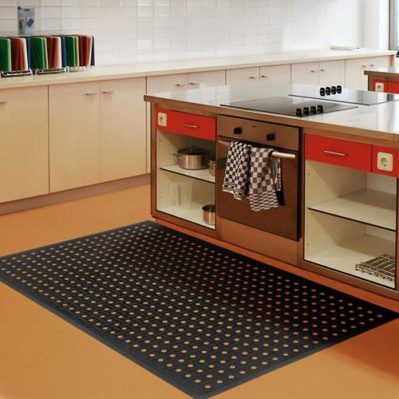Restaurant Managers: Here’s How to Prevent Slips, Trips, and Falls in the Kitchen

Slips, trips, and falls accounted for 27.5% of the 888,220 nonfatal work injuries that resulted in time off in 2019, according to the Bureau of Labor Statistics (BLS).1 The restaurant industry is far from immune to this phenomenon. BLS statistics also show that 7,850 injuries were caused by slips, trips, and falls in full-service restaurants in 2018.2
Most falls occur on a level surface. Loss of traction between a shoe and the walking surface or contact with an object can lead to falls and injuries. These incidents often occur in the kitchen, where a number of potential threats are typically present. The good news is that most, if not all, of these incidents are preventable. Let’s take a closer look at how to prevent falls in the kitchen.
Causes of Kitchen Slips, Trips, and Falls
The common causes of slips, trips, and falls in a restaurant kitchen include:
- Wet, greasy, or recently polished or waxed floors
- Spills of liquid and food materials
- Oily, greasy, or muddy shoes
- Presence of electrical cords or cables
- Tracked-in moisture from rain, hail, snow, ice, or frost
- Wet leaves or other plant matter
- Changes in traction along walking surfaces
- Uneven floors or missing floor tiles
- Unsecured carpets or rugs,
- A lack of adequate lighting
- Use of shoes without adequate grip or support
- Too many people working in a confined space
- Using unstable or inappropriate objects to reach high places
Although a slip and fall in a restaurant kitchen can happen in a variety of ways, there are simple safeguards that can be implemented to significantly reduce the likelihood of these kinds of incidents. It’s not just a matter of creating a safe workplace; it also reduces the legal liability of the owner.

Legal Responsibility of Restaurant Owners
Restaurant owners bear significant legal responsibilities when it comes to ensuring the safety of the premises. This includes taking measures to minimize the risk of slip and fall accidents in the kitchen, which can be a hazardous environment for reasons covered above. The legal obligations of restaurant owners primarily fall under premises liability law.
Duty of Care
Under premises liability law, restaurant owners have a duty of care to ensure that their property is reasonably safe for employees, customers, and any other visitors. This means they must actively identify and address potential hazards that could cause slip and fall accidents. Failing to uphold this duty can result in legal consequences, including liability for injuries sustained on their property.
Restaurant owners must conduct regular inspections and maintenance to identify and fix potential hazards, establish and enforce proper cleaning procedures, train employees on safety protocols, ensure adequate lighting, use clear signage to warn of hazards, and provide appropriate equipment and a safe kitchen layout. By adhering to these practices for slip and fall prevention, they can minimize the risk of accidents and fulfill their duty of care to maintain a safe environment for employees.
Consequences of Non-Compliance
Failure to meet these responsibilities can result in legal action against the restaurant owner. If an employee is injured in a slip and fall accident, they may file a personal injury claim. To succeed, they generally need to prove that:
- The restaurant owner had a duty of care to maintain a safe environment.
- The owner breached this duty by failing to address a known hazard or by not taking reasonable steps to prevent foreseeable risks.
- The breach of duty directly caused the slip and fall accident and resulting injuries.
If the claimant can establish these elements, the restaurant owner may be held liable for damages, including medical expenses, lost wages, and pain and suffering. That’s just one reason why it’s vital to establish proper safety procedures at your restaurant.
Preventing Slip and Fall Accidents in Restaurants
You can prevent falls and injuries at your restaurant or facility kitchen with good housekeeping. Otherwise, the risks of employee injuries and time out of work increase, as do the chances of paying higher insurance rates and incurring regulatory fines and legal penalties.
To maximize restaurant kitchen safety, your slips, trips, and falls policy should include the following procedures as standard operational practice:
Clean Spills Immediately
Wet floors in food preparation areas and general walking surfaces pose a danger to employees and others. Using microfiber mops from Prudential Overall Supply whenever there is a spill or otherwise wet floor can reduce this risk. The longer you wait to eliminate the hazard, the higher the chances of someone inadvertently contacting a wet surface and slipping.
Mark Wet Areas

A “Wet Floor” sign provides a clear indication of danger when the hazard cannot immediately be eliminated. For example, if you’ve just mopped the floor, it will take time to dry. People generally see such signs as a means to avoid a hazard they know about.
Create a Mopping Schedule
A bit of planning ensures everyone knows what needs to be done, by whom, and when. By creating a mopping schedule, you can prevent a buildup of slippery materials. This is especially important if you have an active kitchen.
Make Sure the Kitchen Is Brightly Lit
Fewer injuries occur when work areas are well-lit. Workers can then see and avoid slip hazards. Also, make sure light switches are visible and easily accessible. Make sure all lighting fixtures, switches, and cords are in good repair, and replace those that aren’t.
Do Regular Tripping Hazard Inspections
Your housekeeping program should include inspections accounting for wet/slick areas, moisture sources (such as leaks or water being tracked in by foot), lighting issues, potential sources of spills, and the types of footwear your employees are wearing. Any walkways in and around the kitchen should be free of clutter. The type and condition of flooring surfaces must be accounted for as well.
Make Sure Flooring Has No Bumps or Cracks
Uneven floors, damage to flooring materials, and changes in walking surfaces are common causes of falls and injuries. If necessary, repair, replace, or recoat the floor as soon as any problems are found. This protects kitchen workers who spend all day on foot.
Require Non-Slip Footwear

Slick soles and loose shoelaces can easily trigger a fall. Workers should wear properly fitting, non-slip footwear suited for the types of surfaces in your restaurant. It also improves comfort and helps reduce fatigue.
Place Non-Slip Mats in Areas Near Common Spills or Water
Installing a slip-resistant mat is the fastest and most affordable way to modify a surface to prevent slips, trips, and falls. Some restaurant floor mats have flow-thru designs to allow water to drain. Others have oil and grease-resistant surfaces or coiled zones to reduce fatigue and discomfort.
It’s always worth the time to learn how to reduce slips, trips, and falls in the workplace, and ensure that all employees are properly trained on effective commercial kitchen safety practices.
Order Floor Mats and Uniforms from Prudential Overall Supply
We are a leading supplier of restaurant uniforms, non-slip floor mats, and cleaning supplies. Our focus is on helping business owners create a safe, professional environment, and to that end we provide the most effective kitchen safety products and workplace apparel in the industry. With Prudential in your corner, it’s easy to obtain the accessories you need to establish a proper slips and falls prevention program at your restaurant. Order floor mats and uniforms today or call 800-767-5536 for more information.

Sources:
